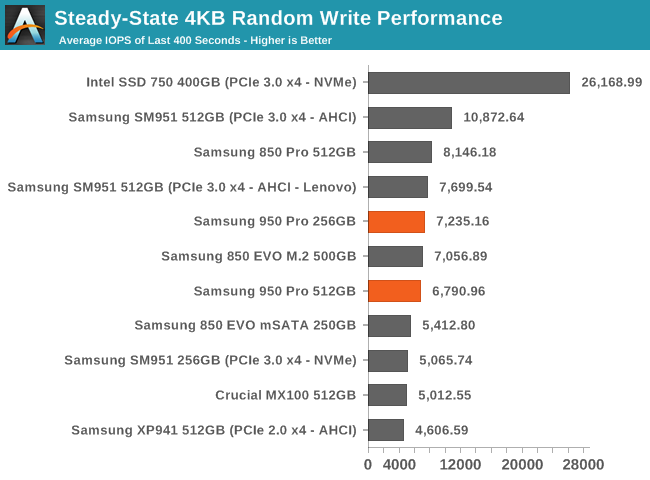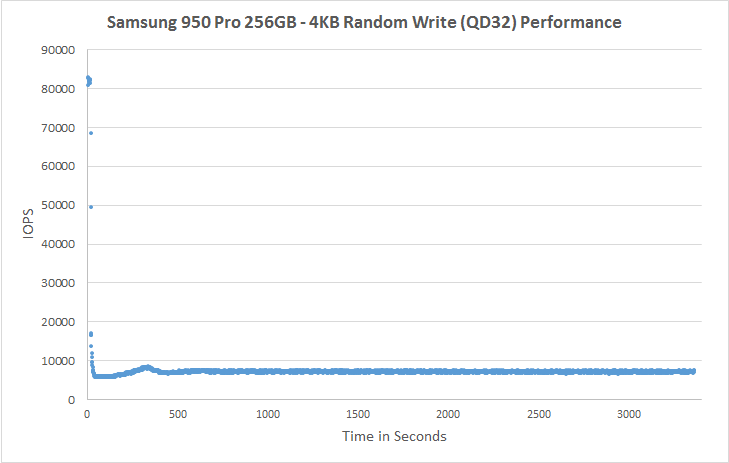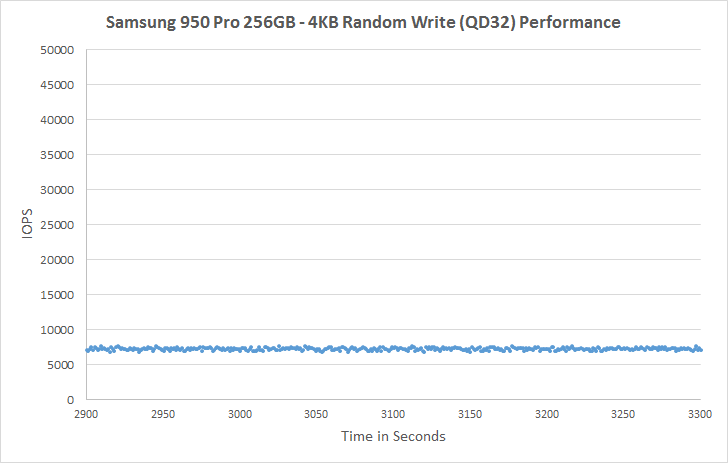The Samsung 950 Pro PCIe SSD Review (256GB and 512GB)
by Billy Tallis on October 22, 2015 10:55 AM ESTPerformance Consistency
Kicking things off, our performance consistency test saturates the drive with 4kB random writes for a full hour, with a queue depth of 32, the maximum supported by the AHCI protocol used by SATA and most PCIe drives. This puts the drive's controller under maximum stress and writes enough data to exhaust all free space and spare area on the drive. This is an unrealistic workload for any client use, but it provides a worst-case scenario for long-term heavy use, and it sheds light on how different SSD controllers behave and if their performance will hold up as they fill up.
The average of the last 400 seconds of the test gives us a steady-state IOPS rating that is usually very different from what the manufacturer specifies for a new, empty drive. We also quantify the consistency of the drive's random write performance, and provide plots of the performance over the course of the test.

Once steady state is reached, performance is determined more by the controller's algorithms than the interface speed, so it's not too surprising to see the 950 Pro performing similarly to other Samsung drives.

The consistency metric shows a surprising disparity between the two 950 Pros, with the 256GB performing much better.
 |
|||||||||
| Default | |||||||||
| 25% Over-Provisioning | |||||||||
Comparing the graphs of the two 950s shows that the inconsistency of the 512GB drive comes from frequent jumps in performance above a solid baseline. This pattern holds even for the test with overprovisioning. Graphing the power consumption over time (not shown) reveals that the periods of lower performance have lower power. If the lower performance were due to periodic background garbage collection, then we would expect power consumption to be at least as high as when the drive is performing well. Instead, it appears that the 512GB drive is experiencing thermal throttling.
 |
|||||||||
| Default | |||||||||
| 25% Over-Provisioning | |||||||||
With most of its time spent thermally limited, our 512GB sample's low average is explained. It appears that the thermal throttling mechanism is bumping the drive down to one of several discrete performance levels, rather than a continuous performance mechanism.










142 Comments
View All Comments
bill.rookard - Sunday, October 25, 2015 - link
VERY interesting. Of particular note is the Crucial MX200 - an older drive, and connected via SATA which trades blows back and forth with the newer PCIe - nvme based drives. Wow, good stuff.Deders - Thursday, October 22, 2015 - link
I think it was only PCIe drives that had long booting times like the Intel 750.Gigaplex - Thursday, October 22, 2015 - link
These are PCIe drives.Deders - Friday, October 23, 2015 - link
I mean slotted drives as the drive controller has to load from the deviceKristian Vättö - Thursday, October 22, 2015 - link
I have a 256GB 950 PRO in my system (AsRock Z170 Extreme 7) and boot time is about 8 seconds with ultra fast boot enabled in BIOS/UEFI.Jacerie - Thursday, October 22, 2015 - link
Why would you go on about how awesome Skylake and the 100 series chipset are for PCIe connected drives and then use a Haswell chip and a Z97 board for the test rig? Time to go back to the bench.Billy Tallis - Thursday, October 22, 2015 - link
The Haswell system is what I've got on hand to test with, and it's what allows my results to be directly comparable with the reviews from earlier this year.Skylake gives you PCIe 3 from the PCH, but on the testbed we always use an x16 slot directly off the CPU for PCIe SSDs, so we don't need Skylake to run the drive at PCIe 3 speeds.
Jacerie - Thursday, October 22, 2015 - link
Will you be posting a follow-up to highlight any controller differences with the newer hardware?MrSpadge - Thursday, October 22, 2015 - link
This is not a SATA controller we're talking about, it's PCIe. And there we have hardly seen any differences between different implementations over the years.hansmuff - Thursday, October 22, 2015 - link
May I humbly request an addition to the review to show performance AND issues when using a PCI Express 2.0 to M.2 adapter on an older platform like the P67A?